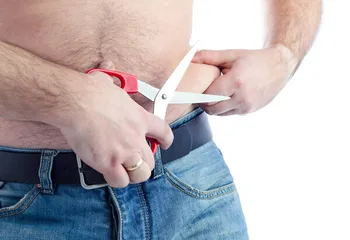99% of women are vulnerable to invisible obesity
When it comes to obesity, people often think of the visible and tangible fat first. In fact, it is not accurate to judge fat and thin by weight, and the fat hidden in the body cannot be ignored.
Women are the biggest victims of invisible obesity
The waist circumference of China is growing rapidly! At present, there are many obese people in China. The standard of obesity in China is different from that in other countries. It has the characteristics of "two small and two big": small body size, small indicators, large belly, and great harm.

"Some people now look well-proportioned and have normal weight, but have high visceral fat. These people's physical condition is worse than those who are obese all over the body." Experts tell people that white adipose tissue is distributed in many parts of the human body and can be divided into two types: visceral obesity and subcutaneous fat obesity. Among them, subcutaneous fat refers to the layer of fat closest to the skin.
Visceral obesity is also known as invisible obesity. Visceral fat mainly exists in the abdominal cavity, such as around and inside organs such as the liver, pancreas, stomach, intestines and other organs. Its obvious manifestation is abdominal obesity, especially women's small belly and waist. From the outside, there is nothing abnormal and can easily be ignored by women, so it is called the most dangerous fat.
How to measure invisible obesity?
So, how should you tell if you have excess visceral fat? The easiest way is to calculate the ratio of waist to hip circumference. You can determine whether there is too much visceral fat with just a tape measure
Step 1: Use a tape measure to measure waist-to-hip ratio waist-to-hip ratio = waist circumference ÷ hip circumference. Method: Stand straight, inhale gently, and use a tape measure to measure the waist circumference above the navel and the most prominent hip circumference. If the waist-to-hip ratio is 0.9 for men and above 0.8 for women, it means that they are at high risk of excessive visceral fat and need to undergo the second-step test immediately.
Step 2: Test the subcutaneous fat in the waist and abdomen. Method: Try pinching around the navel. If you can easily pinch it by 2 centimeters, it means that there is subcutaneous fat accumulating. If you can't pinch it, it means that a lot of fat is accumulating in the internal organs.
It is not difficult to control obesity, the key is three meals a day
Everything must be traced back to its origin. For obese people, irregular diet and low metabolic rate are the root causes. Only by starting from these two aspects can obesity be fundamentally solved.
Breakfast must get rid of the casual street stalls and stay away from fried and puffed food. If you have a nutritious breakfast, don't lose weight! 7-9 a.m. is the time when the small intestine absorbs nutrients most vigorously, and 60% of the daily nutrients required by the human body are absorbed and utilized at this time. Without the nutritional supply at this time, your metabolic ability must be very low. It would be strange if you weren't fat. Even drinking cold water would make you fat. It is recommended to drink a cup of water mixed with protein powder and honey in the morning, and add some fresh fruits. It is simple but the best breakfast, giving sufficient motivation and materials for metabolism.
You can eat enough for lunch, just 70% full. Eat as little as possible at dinner, balanced nutrition, more vegetables, fruits and lean meat, and less greasy and calories. After meals, you can replenish Q and sufficient B vitamins, because no matter what, you must increase the body's metabolic rate, and these two can bring a strong impetus to metabolism, quickly lose weight and shape your body, and prevent rebound. (Editor in charge: Yang Miao)